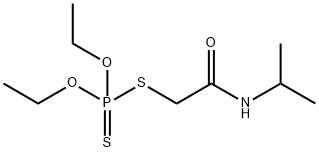PROTHOATE
- CAS No.
- 2275-18-5
- Chemical Name:
- PROTHOATE
- Synonyms
- l343;fac20;fak-40;fostion;oleofac;protoat;telefos;ac18682;ei18682;prothoat
- CBNumber:
- CB1128684
- Molecular Formula:
- C9H20NO3PS2
- Molecular Weight:
- 285.36
- MDL Number:
- MFCD01632787
- MOL File:
- 2275-18-5.mol
| Melting point | 28.5℃ |
|---|---|
| Boiling point | 152-155℃ (0.1-0.2 Torr) |
| Density | 1.151 g/cm3(Temp: 32 °C) |
| refractive index | 1.5182 (589.3 nm 20℃) |
| form | solid |
| pka | 14.12±0.46(Predicted) |
| Water Solubility | 2.5g/L(20 ºC) |
| CAS DataBase Reference | 2275-18-5 |
| EWG's Food Scores | 1-2 |
| FDA UNII | 4V035A5L4B |
| EPA Substance Registry System | Prothoate (2275-18-5) |
SAFETY
Risk and Safety Statements
| Symbol(GHS) |  GHS06 |
|---|---|
| Signal word | Danger |
| Hazard statements | H300-H310-H412 |
| Precautionary statements | P264-P270-P301+P310-P321-P330-P405-P501-P262-P264-P270-P280-P302+P350-P310-P322-P361-P363-P405-P501-P273-P501 |
| Hazard Codes | T+ |
| Risk Statements | 27/28-52/53 |
| Safety Statements | 28-36/37-45-61 |
| RIDADR | 2783 |
| HazardClass | 6.1(a) |
| PackingGroup | I |
PROTHOATE Chemical Properties,Uses,Production
Chemical Properties
White, crystalline solid.Soluble in most organic solvents.
Chemical Properties
Prothoate is an amber to yellow crystalline solid with a camphor-like odor.
Uses
Fungicide, ovicide.
Definition
ChEBI: Prothoate is an organic thiophosphate.
General Description
Colorless crystalline solid, with a camphor-like odor. Technical product is an amber to yellow semi-solid. Used as an insecticide and an acaricide.
Reactivity Profile
Organothiophosphates, such as PROTHOATE, are susceptible to formation of highly toxic and flammable phosphine gas in the presence of strong reducing agents such as hydrides. Partial oxidation by oxidizing agents may result in the release of toxic phosphorus oxides.
Hazard
Toxic by ingestion and skin absorption, cholinesterase inhibitor.
Health Hazard
This is a highly toxic material capable of causing death or permanent injury due to exposures during normal use. Small doses at frequent intervals are additive. Similar to parathion.
Fire Hazard
(Non-Specific -- Organophosphorus Pesticide, n.o.s.) Container may explode in heat of fire. Fire and runoff from fire control water may produce irritating or poisonous gases.
Potential Exposure
A potential danger to those involved in the manufacture, formulation and application of the sys- temic acaricide and insecticide.
Shipping
UN2783 Organophosphorus pesticides, solid, toxic, Hazard Class: 6.1; Labels: 6.1-Poisonous materials.
Incompatibilities
Organophosphates are susceptible to for- mation of highly toxic and flammable phosphine gas in the presence of strong reducing agents such as hydrideds and active metals. Partial oxidation by oxidizing agents may result in the release of toxic phosphorus oxides Compounds of the carboxyl group react with all bases, both inorganic and organic (i.e., amines) releasing substantial heat, water and a salt that may be harmful. Incompatible with arsenic compounds (releases hydrogen cyanide gas), diazo compounds, dithiocarbamates, isocyanates, mercap- tans, nitrides, and sulfides (releasing heat, toxic and possi- bly flammable gases), thiosulfates and dithionites (releasing hydrogen sulfate and oxides of sulfur).
Waste Disposal
In accordance with 40CFR165, follow recommendations for the disposal of pesticides and pesticide containers. Must be disposed prop- erly by following package label directions or by contacting your local or federal environmental control agency, or by contacting your regional EPA office.





